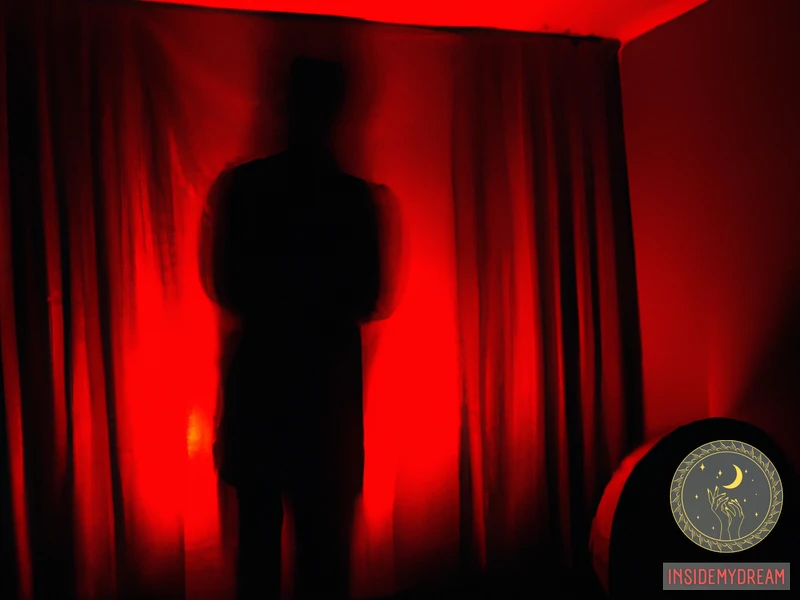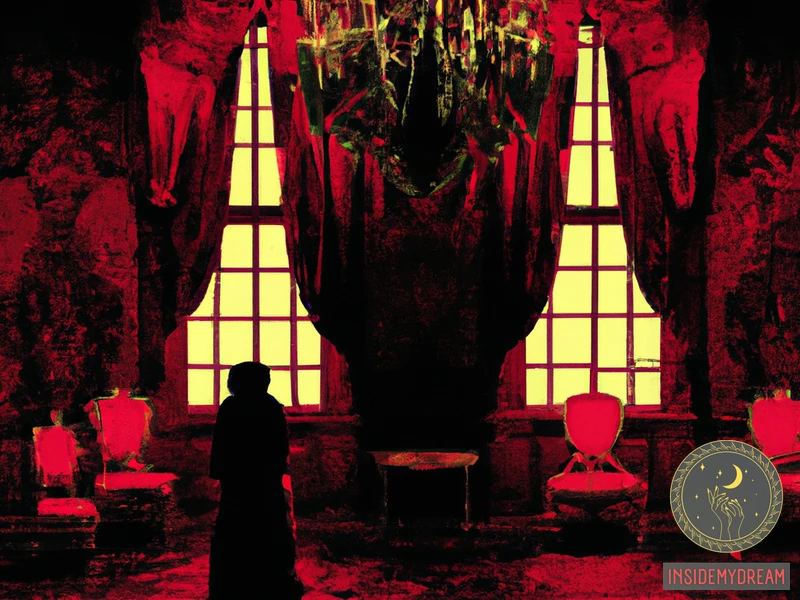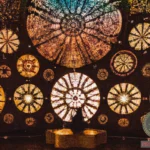As we lay in the realm of dreams each night, our minds transport us to a realm of mystery and wonder. Amidst these nocturnal explorations, certain dreams stand out, leaving us perplexed and intrigued. One such enigmatic dream is the “Red Room” dream. This mysterious vision casts a mesmerizing and haunting crimson hue, beckoning us to uncover the hidden symbolism within its confines.
The allure of the color red has captivated humanity for centuries, symbolizing a range of emotions and concepts. Similarly, the rooms we inhabit hold significant meaning in our lives, representing spaces of comfort, refuge, or even confinement. When the color red meets the imagery of a room, a potent combination of symbolism arises, creating a dream experience that warrants our exploration.
In this article, we will delve into the depths of red room dreams, seeking to understand their essence and decipher their hidden messages. We will examine common scenarios within these dreams, analyze the emotions they evoke, and consider their possible meanings. We will explore how red room dreams have been perceived across different cultures, shedding light on their cultural significance and variations.
However, it’s important to note that not all dreams are pleasant experiences. Nightmares often populate our sleep, causing fear and distress. Red room dreams are no exception, sometimes transforming into nightmarish encounters. We will also address the unsettling nature of these dreams, provide insights into managing and coping with nightmares, and offer guidance for finding solace amidst the dream realm’s darker corners.
So, join us as we embark on this journey, illuminating the enigma of red room dreams one step at a time. Prepare to delve into the depths of symbolism, explore the caverns of the mind, and unravel the secrets that lie within the crimson-painted walls of our subconscious.
Subscribe and Get a Free Dream Journal from Us
Understanding Red Room Dreams

Understanding Red Room Dreams
Red room dreams are a mysterious and intriguing phenomenon that many people experience. These dreams are characterized by the presence of a red room, which holds significant symbolism and meaning. By delving into the symbolism of the color red and the concept of rooms, we can begin to unravel the deeper meaning behind these dreams.
The Symbolism of Red
To understand the significance of red room dreams, it is important to first explore the symbolism of the color red. In many cultures, red is associated with intense emotions such as passion, desire, and anger. It is a color that evokes strong feelings and is often linked to themes of love, power, and energy.
In the context of dreams, the color red can represent a range of emotions and experiences. It may symbolize intense feelings or a heightened state of awareness. Red is also often associated with warnings and danger, making its presence in a dream significant.
The Significance of Rooms
Rooms in dreams often represent different aspects of our lives and consciousness. They can be symbolic of personal space, privacy, and the different roles we play. Rooms can also represent specific areas or domains of our lives, such as our home, workplace, or relationships.
In the context of red room dreams, the room itself becomes an integral part of the symbolism. It represents a contained space where emotions and experiences unfold. The red color within the room adds an additional layer of meaning and intensity to the dream.
Combining Red and Rooms
When red and rooms are combined in a dream, it creates a powerful symbol that represents the intersection of intense emotions and personal space. The red room becomes a space where these intense emotions and experiences are contained and explored.
It is important to note that the interpretation of red room dreams may vary depending on the specific details and context of the dream. The scenarios and symbolism within the dream play a crucial role in understanding the deeper meaning behind it.
The Symbolism of Red
The color red is often associated with intense emotions, power, and passion. In the realm of dream symbolism, red holds significant meaning and can provide valuable insight into the messages our subconscious mind is trying to communicate. Understanding the symbolism of the color red in dreams allows us to delve deeper into the hidden meanings behind our dreams. While the color red may appear in various dream scenarios, it takes on a unique significance when it manifests in the form of a red room. Exploring the symbolism of this mysterious dream scenario can shed light on our innermost desires, fears, and emotions. To fully comprehend the meaning of red room dreams, it is essential to analyze the symbolism of the color red itself, as well as the significance of rooms within the dream realm. This exploration will provide a foundation for decoding the messages behind these enigmatic dreams. The symbolism of red in dreams is a fascinating subject that offers a glimpse into the depths of our subconscious mind. Understanding the symbolism of plants and their significance in dreams is another intriguing topic that can provide further insights into the hidden messages of our dreams.
The Significance of Rooms
Rooms hold a significant symbolic meaning in dreams, representing different aspects of our consciousness, emotions, and experiences. Understanding the significance of rooms in dreams can provide valuable insights into the messages and meanings behind the dream.
1. Personal Space: Rooms in dreams often represent personal space, privacy, and individuality. They can symbolize areas of our lives that are personal or intimate, where we can retreat and be ourselves. The room serves as a representation of our inner world and the boundaries we set for ourselves.
2. Different Areas of Life: Rooms can also represent different areas of our lives, such as work, relationships, or personal growth. Each room may symbolize a specific aspect of our life, allowing us to explore how we navigate and interact in those areas.
3. Inner State of Mind: The condition and appearance of the room in the dream can reflect our inner state of mind and emotions. A cluttered and messy room may represent feelings of chaos or confusion, while a clean and organized room may represent a sense of peace and clarity.
4. Exploration and Discovery: Rooms can symbolize opportunities for exploration and self-discovery. When we enter different rooms in a dream, it can represent our willingness to explore new aspects of ourselves, uncover hidden talents, or explore new paths in life.
5. Subconscious and Unconscious Mind: Rooms in dreams can also serve as gateways to the subconscious or unconscious mind. They can represent areas of our psyche that we may not be fully aware of or have suppressed. Exploring these rooms can lead to a deeper understanding of ourselves and our motivations.
It is important to note that the interpretation of rooms in dreams can vary depending on the individual’s personal experiences and cultural background. To fully understand the significance of a specific room in a dream, it is essential to consider the overall context of the dream and the emotions associated with it.
For more information about other dream symbols, you can read our article on dreaming of dogs.
Combining Red and Rooms
When it comes to analyzing the symbolism of red rooms in dreams, it is important to understand the significance of both the color red and the concept of rooms. Combining these elements can provide deeper insights into the meaning behind red room dreams.
The Symbolism of Red:
Red is a color that is often associated with strong emotions such as passion, anger, and desire. It can represent intense feelings and a sense of urgency. In dreams, the color red often symbolizes vitality, power, and energy. It can also be a symbol of warning or danger.
The Significance of Rooms:
Rooms in dreams often represent different aspects of the dreamer’s life or psyche. They can symbolize personal space, privacy, and areas of exploration. Each room within a dream may hold its own unique symbolism and meaning.
Combining Red and Rooms:
When red and rooms are combined in a dream, it can create a powerful and potentially significant symbol. A red room may represent a space in the dreamer’s life where intense emotions or desires are explored. It can also signify a situation or relationship that is filled with passion or danger.
For example:
– A dream with a red bedroom might symbolize a passionate or intense romantic relationship. It could suggest a deep connection and strong emotions between the dreamer and their partner.
– A red living room in a dream could represent a space where the dreamer expresses their emotions or desires freely. It may indicate a need for emotional release or a desire for excitement in their waking life.
– A dream featuring a red bathroom might symbolize a situation or relationship that is emotionally charged or potentially volatile. It could indicate the need for caution or the presence of hidden emotions and secrets.
Incorporating the color red with the concept of rooms in a dream can add layers of meaning and symbolism. Exploring the specific details and emotions associated with the red room in the dream can provide further insights into its significance and potential messages for the dreamer.
If you want to explore other dream meanings, you can check out this article on psychedelic dream interpretation.
Common Red Room Dream Scenarios
Common Red Room Dream Scenarios
In red room dreams, the specific scenarios that unfold in the dream can provide additional insight into the meaning and symbolism behind the dream. While each dream is unique to the individual experiencing it, there are some common scenarios that occur in red room dreams. Let’s explore these scenarios further:
Scenario 1: Alone in a Red Room
One common scenario is finding oneself alone in a red room. In this scenario, the dreamer may feel a sense of isolation or solitude. The red color of the room can intensify these emotions, evoking feelings of passion, anger, or even danger. The dreamer may wonder why they are in this room alone and what it represents in their waking life.
To gain a deeper understanding of this scenario, it is essential to analyze the emotions and atmosphere within the dream. The dreamer may ask themselves questions such as: How did I feel in the dream? Was I scared, calm, or curious? Was the atmosphere in the room tense or peaceful? All these factors can provide clues to the dream’s meaning.
Scenario 2: Observing Others in a Red Room
Another common scenario is observing others in a red room. In this scenario, the dreamer may feel like a passive observer, watching the interactions and dynamics of the people in the room. The dreamer may wonder why they are not actively participating or why they are on the outside looking in.
This scenario can symbolize feelings of being left out or excluded in waking life. The red room represents a space of intensity and heightened emotions, and the dreamer may feel like they are missing out on these experiences. It may be a reflection of the dreamer’s desire to connect with others or be a part of a particular social group.
Scenario 3: Trapped in a Red Room
Feeling trapped in a red room is another common scenario in red room dreams. In this scenario, the dreamer may experience a sense of confinement or entrapment. The red color can heighten feelings of danger or urgency, adding to the dreamer’s sense of being trapped.
This scenario often represents feelings of being stuck or unable to escape a challenging situation in waking life. The red room symbolizes the intensity and difficulty of the circumstances, and the dreamer may feel overwhelmed or powerless. It may be a sign that the dreamer needs to find ways to break free and regain control in their waking life.
Scenario 4: Red Room as a Portal
In some red room dreams, the red room may serve as a portal or entry point to another world or dimension. In this scenario, the dreamer may experience a sense of exploration or discovery. The red room acts as a gateway to new experiences or hidden aspects of themselves.
This scenario can symbolize the dreamer’s desire for adventure or a willingness to explore the unknown. It may also represent the dreamer’s curiosity about their own subconscious mind and the depths of their psyche. The red room in this context represents a space of transformation and self-discovery.
By analyzing these common scenarios and understanding the emotions and symbolism within each dream, we can begin to unravel the meaning behind red room dreams. In the next section, we will explore different ways to interpret and analyze these dreams to gain a deeper understanding of their significance.
Scenario 1: Alone in a Red Room
Entering a red room in a dream can evoke a range of emotions and thoughts, and one common scenario is finding oneself alone in a red room. This dream scenario raises numerous questions and can leave one feeling perplexed. What is the significance of being alone in a red room? What does the color red represent in this dream context? Is there a deeper meaning behind this dream experience?
In order to understand the symbolism behind being alone in a red room, it is important to explore the significance of the color red and the concept of rooms in dreams. Red is often associated with passion, intensity, and strong emotions. It can represent both positive and negative emotions such as love, anger, and power. Rooms, on the other hand, can symbolize different aspects of one’s life or mind, representing a contained space where thoughts and emotions reside.
Combining the symbolism of red and rooms, being alone in a red room can suggest a heightened state of emotions or intensity in one’s personal life. It may indicate a need to explore and understand powerful emotions, whether positive or negative, that are currently being experienced.
To further delve into the meaning of being alone in a red room, it is essential to analyze the feelings and emotions experienced during the dream, as well as the atmosphere of the room and any personal associations one may have with the color red or the concept of rooms. Additionally, considering one’s current life circumstances and any potential connections between the dream scenario and waking life events can provide valuable insight into the dream’s meaning.
Ultimately, being alone in a red room in a dream can signify a deep exploration of passionate emotions, the need for self-reflection, and an opportunity for personal growth. Let’s now explore some common scenarios that can be encountered in red room dreams.
Scenario 2: Observing Others in a Red Room
Observing others in a red room is another common scenario that people may experience in their red room dreams. In these dreams, the dreamer finds themselves in a red room but instead of being alone, they are surrounded by other people. The dreamer may or may not know these individuals, and the interactions within the dream can vary.
In this scenario, the dreamer takes on the role of an observer, watching the actions and behaviors of others in the red room. The red room serves as a backdrop for these interactions, adding a layer of symbolism to the dream.
When observing others in a red room, it is important to pay attention to the dynamics between the dreamer and the other people present. Are they engaging in pleasant conversations and activities, or is there tension and conflict? The way the dreamer feels while observing others can provide key insights into the overall meaning of the dream.
Alternatively, the dreamer may feel detached or disconnected from the individuals in the red room. They may feel like an outsider, unable to fully participate or engage with the others present. This sense of detachment could indicate a feeling of isolation or a lack of connection in the dreamer’s waking life.
It is also worth noting the actions and behaviors of the people in the dream. Are they acting in a way that aligns with their usual behavior, or are they behaving out of character? This can provide clues about how the dreamer perceives these individuals and can reflect the dreamer’s subconscious thoughts and feelings about them.
To fully interpret a red room dream where the dreamer is observing others, it is important to consider the context of the dreamer’s waking life. Are there any specific relationships or situations that the dream could be reflecting? For example, if the dreamer recently had a conflict with a friend or a coworker, the dream may be reflecting their concerns or anxieties about that situation.
Ultimately, the meaning of observing others in a red room dream will vary depending on the specific details and emotions experienced by the dreamer. It is important to take into account the individual’s personal experiences and associations with the color red and the concept of rooms. By analyzing these factors, the dreamer can gain a deeper understanding of the symbolism and meaning behind their red room dream.
For more information on dream meanings, you can read about the symbolism of someone kissing a part of the body in dreams.
Scenario 3: Trapped in a Red Room
When dreaming about being trapped in a red room, it can evoke feelings of confinement, fear, and helplessness. This scenario often represents a sense of being stuck or restrained in some aspect of your life. The red color intensifies these emotions, adding a sense of urgency and intensity to the dream.
In this dream scenario, the individual finds themselves unable to escape the red room. The room may be small and cramped, making it even more challenging to maneuver or find a way out. The walls, furniture, and decor are all red, creating a suffocating atmosphere.
Trapped in a Red Room
Dreaming about being trapped in a red room can symbolize a variety of different situations in waking life. Here are a few possible interpretations:
1. Feeling Stuck or Restrained: This dream scenario may reflect a sense of being trapped or limited in your daily life. It could represent a job that you feel confined by or a relationship that feels constricting. The dream may be trying to communicate a need for change and a desire for freedom.
2. Emotional Confinement: The red room may symbolize intense emotions or unresolved feelings that are keeping you trapped. It could indicate that you are feeling overwhelmed or unable to express your emotions fully. This dream may be urging you to address and release these emotions in order to find emotional release and freedom.
3. Desire for Independence: Being trapped in a red room could also signify a longing for independence and autonomy. It may suggest that you are yearning for more freedom and a sense of control in your life. This dream could be a reflection of your subconscious desire to break free from any limitations or constraints that are holding you back.
4. Fear or Anxiety: The feeling of being trapped in a red room can also be associated with fear or anxiety. It may indicate that there are unresolved fears or anxieties that are preventing you from moving forward or making progress. This dream scenario could be a reminder to confront and overcome these fears in order to regain a sense of control and freedom.
It is important to consider the specific emotions and details present in the dream when interpreting its meaning. Reflect on your current life circumstances, any feelings of entrapment or frustration, and consider seeking guidance from a therapist or counselor if these dreams persist and cause significant distress.
If you’d like to learn more about dream meanings, you can read our article on meeting a traveler in a dream or interpretation of seeing a hawk in a Christian dream.
Scenario 4: Red Room as a Portal
In the scenario where the red room is perceived as a portal, the dreamer may find themselves transported to another world or dimension through the red room. This dream experience can be both fascinating and perplexing, as it represents a shift in reality and the exploration of unknown realms.
The Red Room as a Gateway to Another World
In this scenario, the dreamer enters the red room and suddenly finds themselves in a completely different environment. It may be a fantastical place with vibrant landscapes, mystical creatures, or surreal architecture. The red room serves as the doorway or portal through which the dreamer accesses this alternate reality.
This dream scenario suggests a desire for adventure, escape, or a longing to explore new possibilities and experiences. The red room symbolizes the transitional space between the known and the unknown, the ordinary and the extraordinary. It signifies the dreamer’s willingness to step outside their comfort zone and embark on a journey of discovery.
Spiritual and Metaphysical Exploration
For some individuals, the red room as a portal may have deeper spiritual or metaphysical connotations. It can represent a connection to the subconscious mind or a higher plane of consciousness. The dreamer may experience a sense of enlightenment or awakening as they traverse through the red room into a realm of spiritual significance.
This dream scenario can also indicate the dreamer’s curiosity about the mysteries of life and the pursuit of spiritual growth. It reflects a desire to explore different belief systems, philosophies, or spiritual practices in order to gain a deeper understanding of oneself and the universe.
Seeking Answers and Revelation
The red room as a portal may also represent the dreamer’s search for answers or revelation. It symbolizes a quest for knowledge, truth, or insight. By entering the red room and passing through the portal, the dreamer hopes to uncover hidden truths, unravel mysteries, or gain clarity about a particular situation or aspect of their life.
This scenario suggests that the dreamer is actively seeking guidance or solutions to their problems. The red room serves as a metaphorical gateway to enlightenment or revelation, offering the dreamer an opportunity to access the wisdom and knowledge that lies beyond the confines of their current reality.
Interpreting Red Room Dreams

Dreams involving red rooms can be incredibly intriguing and often leave dreamers with a sense of mystery and curiosity. While the meaning of dreams can vary greatly depending on the individual and their personal experiences, there are some general interpretations that can help shed light on the symbolism of red room dreams.
One important aspect to consider when interpreting red room dreams is the feelings and emotions experienced within the dream. Red is a color often associated with intense emotions such as passion, anger, and love. The emotions felt within the dream can provide valuable insight into its meaning.
For example, if the dreamer feels anxious or fearful in the red room, it could reflect a sense of danger or warning sign in their waking life. This may indicate that there are hidden threats or challenges they need to be aware of and cautious about.
On the other hand, if the dreamer feels a sense of excitement or joy in the red room, it could signify a desire for exploration and adventure. It may suggest that the dreamer is craving new experiences or looking for a way to break free from their routine.
The atmosphere of the red room in the dream can also provide valuable clues for interpretation. Is the room dimly lit or brightly illuminated? Is it cluttered or neat and organized? These details can give insight into the dreamer’s state of mind and emotions.
For instance, a dimly lit and cluttered red room may suggest that the dreamer is feeling overwhelmed and overwhelmed by their emotions and thoughts. It could be a sign that they need to take some time to declutter their mind and find clarity.
Conversely, a brightly illuminated and well-organized red room may indicate a sense of control and stability in the dreamer’s life. It could suggest that they have a clear vision and are actively working towards their goals.
Another important aspect to consider when interpreting red room dreams is the dreamer’s personal associations with the color red and rooms. Red can have different meanings for different individuals based on their cultural background, personal experiences, and beliefs.
For example, someone who associates red with love and passion may interpret a red room dream as a reflection of their romantic or sexual desires. On the other hand, someone who has experienced trauma or danger in a red room may interpret the dream as a reminder of those past experiences.
By examining their personal associations, the dreamer can gain deeper insight into the meaning of their red room dream.
Lastly, it’s important to consider the dreamer’s current life circumstances when interpreting red room dreams. Dreams often reflect the dreamer’s thoughts, emotions, and experiences, both past and present.
For instance, if the dreamer is currently going through a period of intense emotions or upheaval, a red room dream may simply be a reflection of their current state of mind. It may indicate that they are feeling overwhelmed or emotionally charged in their waking life.
Similarly, if the dreamer is facing a situation that requires boldness and assertiveness, a red room dream may symbolize their need to tap into their inner strength and confidence.
By taking into account the dreamer’s current circumstances, the interpretation of the red room dream can be better understood and applied to their waking life.
Interpreting red room dreams is a complex process that requires careful consideration of the dreamer’s emotions, the atmosphere of the room, personal associations, and current life circumstances. By delving deeper into these aspects, one can gain valuable insights into the possible meanings behind these mysterious dreams.
Exploring Feelings and Emotions
Exploring the depths of our dreams can reveal a plethora of insights into our subconscious mind. One crucial aspect to delve into is the emotions and feelings that arise within us during these dream experiences. In the realm of dream interpretation, understanding the significance of our emotions can provide valuable clues to unravel the hidden meanings behind our dreams.
Dreams have the extraordinary ability to evoke a wide range of emotions, and red room dreams are no exception. These dreams can often leave us perplexed, with an overwhelming surge of feelings that can vary from excitement to fear, or even a sense of foreboding. By examining these emotions and understanding their underlying symbolism, we can gain a deeper understanding of our inner desires, fears, and thoughts.
As we navigate the mysterious world of dream interpretation, it is essential to explore the multifaceted nature of our emotions within the context of a red room dream. By analyzing the unique atmosphere and emotional landscape of the dream, we can unlock hidden messages and gain valuable insights into our waking lives. Through careful introspection and reflection, we can begin to unravel the intricate web of symbolism woven within the red room dreamscape.
To fully comprehend the emotions and feelings within a red room dream, it is crucial to consider various factors such as the room’s ambiance, the presence of other individuals, and our personal associations with the color red. Additionally, exploring our current life circumstances and any underlying stressors can offer valuable context for interpreting the emotions within the dream. By examining these key elements, we can begin to decode the messages our subconscious is attempting to convey.
As we embark on this exploratory journey through the realm of emotions within red room dreams, we will uncover the possible meanings of these dreams, including passion and intensity, secrets and hidden aspects, danger and warning signs, desire for exploration, and emotional overload. To further enhance our understanding, we will also delve into the cultural and symbolic significance of the color red and its representation in Western and Eastern cultures, as well as its portrayal in literature and art.
Before delving into the various interpretations and meanings associated with red room dreams, it is crucial to acknowledge that dreams can occasionally turn into nightmares, resulting in intense fear and distress. In the next section of this article, we will address the topic of nightmares, explore their causes, and provide strategies for managing and coping with them effectively.
These dreams may occur during times of heightened stress or when you are grappling with strong feelings that you find difficult to process. The red room becomes a manifestation of the emotional turmoil within you, serving as a visual representation of the intensity and depth of your emotions.
In these dreams, pay attention to how you feel while in the red room. Are you overwhelmed, anxious, or agitated? These emotions can provide valuable clues to the specific emotions you may be struggling with in your waking life.
It is important to take note of any recurring red room dreams, as they may indicate a pattern of emotional overload that requires attention and self-reflection. These dreams can serve as a wake-up call to engage in practices that help you manage and process your emotions in a healthy way.
If you find yourself frequently having red room dreams, it may be beneficial to explore techniques such as journaling, meditation, or seeking professional counseling to better understand and cope with your emotions.
Remember, dreams have a way of bringing to the surface thoughts and emotions that are often hidden or suppressed in our waking lives. Red room dreams, in particular, can offer insight into the importance of addressing and finding healthy outlets for our intense emotions.
Red Room Dreams Across Cultures

In exploring the symbolism of red room dreams, it is fascinating to delve into how these dreams are interpreted across different cultures. The color red holds various meanings and associations in different parts of the world, and understanding these cultural perspectives can shed further light on the significance of red room dreams.
Red Symbolism in Western Culture:
In Western culture, the color red often represents passion, love, and excitement. It is associated with strong emotions and intense experiences. In the context of red room dreams, this symbolism suggests a dreamer’s desire for passion and intensity in their waking life. The dream may be a reflection of a longing for deep connections or a need for more excitement and stimulation.
Additionally, red is often associated with power and authority. In some Western cultures, a red room might be linked to wealth and luxury, as seen in opulent, grandiose red-themed rooms in palaces and mansions. In the context of dreams, this symbolism could suggest that the dreamer desires status, success, or a sense of control in their life.
Red Color Symbolism in Eastern Cultures:
In many Eastern cultures, red represents good luck, celebration, and happiness. It is also closely linked to traditional ceremonies, such as weddings and festivals. Red is believed to bring prosperity and ward off evil spirits. In the context of red room dreams, this symbolism suggests a positive and auspicious meaning. It may indicate that the dreamer is entering a phase of good fortune and joy in their life.
Red is associated with passion and vitality in Eastern cultures as well. It symbolizes strong emotions and desires. In the context of dreams, a red room may reflect the dreamer’s yearning for passion, romance, or fulfillment in their personal relationships or creative pursuits.
Red Rooms in Literature and Art:
The symbolism of red rooms extends beyond just dreams and cultural associations. Throughout literature and art, red rooms have been used to convey various themes and meanings. For example, Charlotte Bronte’s novel “Jane Eyre” features a mysterious locked red room in Thornfield Hall, which represents the hidden secrets and traumas of the protagonist’s past.
In art, red rooms are often depicted to evoke intense emotions or psychological states. Artists such as Henri Matisse and Mark Rothko have used red extensively in their paintings to capture the viewers’ attention and evoke a range of feelings, from passion and desire to anger and anxiety. These artistic representations of red rooms can influence the interpretations and perceptions of red room dreams.
Conclusion:
The interpretation of red room dreams across cultures showcases the diverse symbolism associated with the color red. From passion and intensity to celebration and luck, red holds multifaceted meanings that can influence the way dreamers perceive and interpret their dreams. By understanding the cultural associations and artistic representations of red rooms, we can gain deeper insights into the possible meanings and messages behind these mysterious dreams.
Red Symbolism in Western Culture
Red has long been a symbol of power, passion, and intensity in Western culture. Its vibrant and fiery hue often evokes strong emotions and captivates the human imagination. Throughout history, red has been associated with a myriad of meanings, from love and desire to danger and warning signs. In this section, we will delve into the rich symbolism of red in Western culture, exploring its significance in various contexts, including art, literature, and everyday life. Let us embark on a journey to uncover the complexities and perplexities of red symbolism in Western culture.
Red Color Symbolism in Eastern Cultures
In Eastern cultures, the color red holds significant symbolism and meaning. It is often associated with luck, prosperity, joy, celebration, and good fortune. Let’s explore some of the specific interpretations of red in different Eastern cultures:
| Eastern Culture | Symbolism of Red |
|---|---|
| China | In China, red is considered the most auspicious color. It is associated with celebrations and is often used during festivals, weddings, and other joyous occasions. Red is believed to bring luck, happiness, and fortune, and it is also believed to ward off evil spirits. |
| Japan | In Japan, red holds both positive and negative symbolism. On one hand, it represents life, vitality, and courage. On the other hand, red is also associated with danger and warning. In traditional Japanese culture, red is commonly used in Shinto ceremonies and festivals, symbolizing purity and spiritual cleansing. |
| India | In India, red is a vibrant and powerful color that carries various meanings. It is often associated with love, passion, and fertility. Red is also considered an auspicious color and is used in weddings and religious ceremonies. In Hinduism, red is associated with the divine feminine energy and is often seen as the color of the goddesses. |
| South Korea | In South Korea, red is closely connected to traditional culture and is often associated with royalty, power, and wealth. It is commonly used in traditional clothing, such as the hanbok (the traditional Korean dress), to signify beauty and elegance. Red is also seen as symbolizing good luck and protection. |
In these Eastern cultures, the color red not only represents luck and celebration but also has deep cultural and spiritual significance. It is a color that evokes strong emotions and is often used to invoke positive energy and vitality. Its association with auspicious events and rituals makes it a color that is highly valued and respected.
Red Rooms in Literature and Art
Red Rooms in Literature and Art
Red rooms have made their way into various forms of literature and art, serving as potent symbols and contributing to the overall themes of the works. Here are a few notable examples where red rooms have been prominently featured:
1. “The Masque of the Red Death” by Edgar Allan Poe: In this Gothic short story, the red room is a central element. It represents the horrors of the disease plaguing the land and symbolizes the inevitability of death. The vibrant red color creates a sense of ominousness and impending doom throughout the story.
2. “Jane Eyre” by Charlotte Bronte: In this classic novel, the Red Room serves as a haunting childhood memory for the protagonist, Jane Eyre. It is a secluded room where Jane was once locked up after a fit of rage. The red color in this context represents anger, repression, and the traumatic experiences of Jane’s past.
3. “Twin Peaks” series by David Lynch: The iconic Red Room in the acclaimed television series “Twin Peaks” holds a significant place in the narrative. It is a surreal and dreamlike space where the boundaries of reality are blurred. The red curtains, flooring, and furniture not only add to the enigmatic atmosphere but also symbolize the presence of supernatural forces and the subconscious mind.
4. “The Shining” by Stephen King: The Red Room in this chilling horror novel has a haunting presence. It is described as a forbidden space, and its appearance changes, leaving the characters disoriented and terrified. The red color in this context symbolizes danger, madness, and the supernatural.
5. “The Red Room” by H.G. Wells: Fittingly titled, this short story revolves around a character’s encounter with a haunted room. The red color represents fear, mystery, and the unknown. Wells expertly uses the symbolism of the red room to create a sense of tension and anticipation.
These examples demonstrate the versatility of red rooms in literature and art. Whether used to evoke fear, mystery, or intense emotions, the symbolism of the red room adds depth and intrigue to the works in which they are featured.
When Red Room Dreams Turn into Nightmares
When individuals experience red room dreams, they may find that these dreams can sometimes take a frightening turn and become nightmares. Nightmares are intense, vivid dreams that evoke feelings of fear, distress, and anxiety. These dreams can be emotionally overwhelming and often leave individuals feeling unsettled upon waking up.
Understanding why red room dreams turn into nightmares requires delving into the factors that contribute to the occurrence of nightmares in general. Nightmares can be caused by a variety of factors, including stress, trauma, anxiety, or even certain medications. They may also be influenced by personal experiences, memories, and emotions.
For those who frequently have red room nightmares, it is important to explore the specific triggers or themes that may be causing these disturbing dreams. One possible explanation could be the association of the color red with danger, intensity, or fear in the individual’s subconscious mind. The red room may symbolize a threatening or overwhelming situation in the dreamer’s life, which manifests as a nightmare.
Another reason for the transformation of red room dreams into nightmares could be the presence of feelings of powerlessness or being trapped within the room. This feeling of confinement or helplessness can evoke feelings of fear and anxiety, leading to a nightmare experience. Additionally, if the dreamer has unresolved trauma or unresolved emotional issues associated with the color red or being in a confined space, these unresolved feelings could also contribute to the nightmarish quality of the dream.
Managing and coping with nightmares is crucial for maintaining a healthy sleep pattern and overall well-being. One effective way to cope with nightmares is to establish a relaxing bedtime routine that helps calm the mind before sleep. Engaging in activities such as reading a book, taking a warm bath, or practicing relaxation techniques can all contribute to a peaceful mindset before bedtime.
It can also be helpful to keep a dream journal and record any recurring themes or symbols in the red room nightmares. By identifying and understanding these patterns, individuals may gain insight into the underlying issues that are causing the nightmares. This self-reflection and exploration can then be used in therapy sessions or discussions with a mental health professional to work through the emotions and experiences associated with the dreams.
In some cases, individuals may benefit from seeking professional help or therapy, especially if the nightmares are causing significant distress or impacting their daily life. A therapist experienced in dream analysis or trauma therapy can guide individuals through the process of exploring and resolving the underlying issues that may be contributing to the nightmares.
When red room dreams turn into nightmares, it is important to address the emotional and psychological aspects behind these dreams. By understanding the triggers, seeking support, and implementing coping mechanisms, individuals can effectively manage and navigate through these unsettling dreams, leading to a healthier and more restful sleep experience.
Understanding Nightmares and Their Causes
When it comes to exploring the world of dreams, nightmares are often an intriguing and perplexing aspect. They can leave us feeling frightened, disturbed, and questioning their meaning. In this section, we will delve into the realm of nightmares, specifically focusing on understanding them and their underlying causes. Nightmares can offer valuable insights into our subconscious mind, revealing hidden fears, anxieties, and unresolved issues. By deciphering the symbolism and deciphering the causes of nightmares, we can begin to unravel the mysteries behind these unsettling dreams. So let us embark on this journey of understanding as we delve into the depths of our nighttime fears.
Managing and Coping with Nightmares
One of the most distressing aspects of red room dreams is when they turn into nightmares. Nightmares can be incredibly vivid and intense, leaving us feeling scared, anxious, and unsettled upon waking. Coping with nightmares is essential to ensure a good night’s sleep and maintain a sense of well-being. Here are some strategies for managing and coping with nightmares:
Create a Relaxing Bedtime Routine: Establishing a calming routine before bed can help ease anxiety and promote more peaceful sleep. Engage in activities such as reading a book, taking a warm bath, or practicing relaxation techniques like deep breathing or meditation. By relaxing the mind and body before sleep, you may minimize the occurrence of nightmares.
Avoid Stimulants: Stimulants such as caffeine, nicotine, and alcohol can disrupt sleep patterns and contribute to the likelihood of experiencing nightmares. It is advisable to limit or avoid consuming these substances close to bedtime.
Keep a Dream Journal: Keeping a dream journal can be beneficial in understanding recurring patterns or themes in your dreams, including nightmares. Take a few minutes each morning to write down any details you remember from your dreams, including emotions, symbols, or events. This practice can help you gain insights into the underlying factors that may be contributing to your nightmares.
Practice Lucid Dreaming Techniques: Lucid dreaming refers to the ability to become aware that you are dreaming while still in the dream state. By practicing lucid dreaming techniques, such as reality checks or visualization exercises, you may be able to gain control over your dreams, including nightmares. This can empower you to change the dream’s outcome or wake yourself up if the dream becomes too distressing.
Seek Support: If nightmares persist and significantly affect your quality of life, it may be helpful to seek support from a therapist or counselor. They can assist you in exploring any underlying psychological or emotional issues that may be contributing to the nightmares and provide you with coping strategies tailored to your individual needs.
Practice Relaxation Techniques: Engaging in relaxation techniques, such as progressive muscle relaxation or guided imagery, can help reduce anxiety and promote deep relaxation. These techniques can be particularly helpful when practiced before bed or during times of heightened stress. By learning to relax your mind and body, you may experience fewer nightmares.
Create a Soothing Sleep Environment: Creating a calm and comfortable sleep environment can contribute to more restful sleep and decrease the likelihood of nightmares. Ensure your bedroom is dark, quiet, and at a comfortable temperature. Use soft lighting, calming colors, and soothing scents like lavender to create a tranquil atmosphere that promotes peaceful sleep.
Maintain a Healthy Lifestyle: Living a healthy lifestyle can have a positive impact on sleep quality and dream patterns. Engage in regular exercise, practice stress management techniques, and maintain a balanced diet. By taking care of your physical and mental well-being, you may experience fewer nightmares.
It’s important to remember that managing nightmares takes time and patience. However, by implementing these coping strategies and developing a better understanding of your dreams, you can begin to regain control over your sleep and reduce the frequency and intensity of red room nightmares.
Conclusion
In conclusion, red room dreams hold deep symbolism and can provide valuable insights into our subconscious mind. The color red itself represents passion, intensity, and energy, while the concept of a room signifies a specific area of our lives or aspects of ourselves.
Through common scenarios in red room dreams, such as being alone, observing others, feeling trapped, or using the room as a portal, our psyche communicates various messages to us. By interpreting these dreams, we can gain a better understanding of our emotions, analyze the atmosphere of the room, explore personal associations, and consider our current life circumstances.
The possible meanings of red room dreams include themes of passion and intensity, secrets and hidden aspects, danger and warning signs, a desire for exploration, and emotional overload. These dreams can differ across cultures, where the symbolism of the color red varies. In Western culture, red often represents vitality and power, while in Eastern cultures it is associated with luck and celebration.
Red rooms have also made appearances in various forms of art and literature, further adding to their intriguing nature. The interpretation of these dreams becomes even more significant when they evolve into nightmares. Understanding the causes of nightmares and implementing coping strategies can help manage the negative effects they may have on our well-being.
In essence, red room dreams serve as a window into our deepest emotions and desires. Exploring the symbolism and meaning behind these dreams allows us to delve into our subconscious and gain a deeper understanding of ourselves. By embracing and interpreting these dreams, we can harness their wisdom and use it to navigate our waking lives more consciously.
Frequently Asked Questions
FAQ 1: Are red room dreams common?
Red room dreams are relatively common, as many people have reported experiencing them at some point in their lives.
FAQ 2: What does the color red symbolize in dreams?
In dreams, the color red often symbolizes passion, strong emotions, power, and intensity.
FAQ 3: Why are rooms significant in dream symbolism?
Rooms in dream symbolism represent different aspects of the dreamer’s psyche, personal space, or specific situations or experiences.
FAQ 4: What does it mean to be alone in a red room in a dream?
Being alone in a red room in a dream can signify a deep exploration of one’s own intense emotions, desires, or personal experiences.
FAQ 5: What does it mean to observe others in a red room in a dream?
Observing others in a red room in a dream may suggest a desire to understand or analyze the emotions or actions of those around you.
FAQ 6: What does it mean to feel trapped in a red room in a dream?
Feeling trapped in a red room in a dream can indicate a sense of being overwhelmed by intense emotions or circumstances in your waking life.
FAQ 7: What does a red room as a portal represent in dreams?
A red room as a portal in a dream can symbolize a transition or a journey into a deeper understanding of oneself or a new phase in life.
FAQ 8: How can I interpret the meaning of my red room dream?
Interpreting the meaning of a red room dream involves exploring your feelings and emotions, analyzing the room’s atmosphere, examining personal associations, and considering your current life circumstances.
FAQ 9: What are some possible meanings of red room dreams?
Possible meanings of red room dreams include passion and intensity, secrets and hidden aspects, danger and warning signs, desire for exploration, and emotional overload.
FAQ 10: Do red room dreams have cultural significance?
Yes, red room dreams can have cultural significance. In Western culture, red symbolizes love, passion, and power, while in Eastern cultures, it can represent luck, celebration, and happiness.










